
Dance as a Metaphor for Life - Reflections on a River!
- Ramaa Bharadvaj
e-mail: ramaabharadvaj@gmail.com
March 31, 2016
A note to the readers …
I had been asked by the editor of Narthaki to write a report about
choreographer Astad Deboo’s production ‘Rhythm Divine II: River Runs
Deep’ a month ago, but could not get to it for personal reasons. As I
sit now to write this, so far away from the event, I am thrilled for
this lapse of time because no more do the scene-by-scene details beam
their immediate smile. Like the enchantment of youth, beauty, glamour
and glories of Life, those details have all waned! What is left however
is the soul of the choreography that continues to provoke, permeate and
haunt thus transforming what should have been a ‘report’ into a
‘reflection’! Hope both those who have seen the work and those who wish
to see it will find it interesting. – Ramaa Bharadvaj
Water has often been used in poetry and literature as a metaphor for
Life and its quest for freedom and spiritual revelations. But when
dancer Astad Deboo invites water into his choreographic portal, it does
more than flow out as a metaphoric stream; it cascades in torrents of
imaginative visual imagery transforming his dance itself into a metaphor
for Life - and he calls it ‘Rhythm Divine II: River Runs Deep.’
Both the venue (the hallowed Kalakshetra theater) and the occasion
(Remembering Rukmini Devi Festival) turn out to be most appropriate for
its staging, for they provide the ideal challenge to Astad – to keep
this audience consisting largely of Bharatanatyam dancers and
Cutcheri-cherishing Chennai viewers engaged through his own contemporary
style, which is a unique amalgam of his Kathak, Kathakali and western
modern dance trainings. I had travelled from Bangalore to Chennai
especially to see his work, and that evening, at the end of the
90-minute cruise along his “River”, one thing becomes apparent. A clear
choreographic vision can get the essence of a dance to transcend the
style/genre barrier and penetrate the heart and stir the psyche.
Concept ...
The intriguing two-part title (‘Rhythm Divine II: River Runs Deep’)
seems to accurately hint at the nature of the work that is about to
unfold on stage. Astad draws once again from his long time association
with Guru Seityaban Singh and his pung cholom drummers of the Shri Shri
Govindji Nat Sankirtan group from Imphal, Manipur. As in the title, he
juxtaposes two distinct and divergent sets of concepts, movement
patterns and energetic variations, and throughout the work they run
parallel with an apparent rhythm – quite like the rhythm of Life itself!
Like a train that straddles dual tracks, it carries us the ‘travelers’
through contrasting dance-landscapes:
- one accelerating to a frenzy and the other decelerating almost to a deliberate pause;
- one in vigorously large whirls and the other in minutest shivers;
- one in thunderous excitement and the other in gentle serenity.
The two performance styles – the traditional grandeur of the drummers
and Astad’s sheer minimalism - seem to both collide as well as
complement, follow each other as well as co-exist, merge as well as
diverge. And holding all these extremes together is Astad’s clear
conceptual inspiration – the socio-political condition of North-eastern
India, which he describes as:
“... a heartbreaking amalgam of natural beauty and militant aggression, of
lightning moves and glacial response, the turbulence of politics and
the calm pace of tradition, flowing one below the other like twin
rivers.”
Choreography...
It is Astad’s skill in being able to ‘graph’ or write the scene through
dance that captures the imagination. There is none of that comfortable
familiarity of sitting through a classical dance work, which is
supported by a familiar story source, characterizations and a
conventional gestural idiom. Instead, the first thing that happens is
the stripping of any superficial satisfaction of having fully
‘understood’ the work. Astad does this by slowly pulling the viewer away
from the intellectual obsession of wanting to know the meaning of every
gesture. The mind however does not leave so easily. It resists, screams
silently, wanders, turns itself off, attempts to sneak its way into
crevices in search of ‘meaning’ and then finally gives up! And that is
when it happens! Layers of interpretations begin to organically unfold
within, and we find that we are no longer a passive (even lackadaisical)
receiver but have become an involved co-creator.
Astad once said in a TEDx talk, “You (viewers) take back what you would
like to take back even though there is an explanation,” and in ‘River
Runs Deep,’ the ‘explanation’ is the spine of his story - of political
strife and volatility of life. However, this is not a story of despair
and gloom, but one of hope about the endurance of beauty and art, a
story with a strong biographical touch.
Slide show
Photos: Amit Kumar
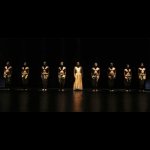
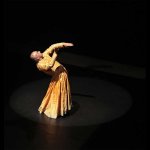
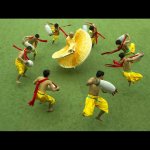 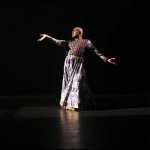
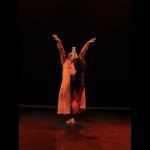
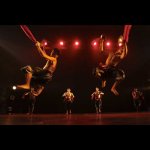 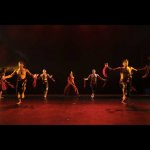
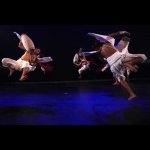
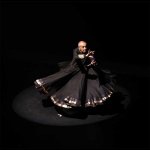
Reflections on Highlights...
1. If ‘Dance’ as a total experience is like a temple,
its four pillars are Technique, Music, Costumes and Stage-ambience. Even
if one of these pillars is weak, the structure as a whole suffers.
Fortunately for ‘River Runs Deep,’ it is supported by four equally
strong pillars. Let’s take lighting for example. Viewers are not
tormented with the cartoonish “blue-for-aqua, green-for-garden,
red-for-fire” saturation-torture technique. Instead, we are treated to
plenty of quiet spaces – the space that is treasured in graphic design
as white space, in music as silence, in dance as stillness and in
lighting as dark zones. Watching the dancers appear and disappear
through these zones is as enchanting as viewing comets zoom by in the
majestic darkness of Space.
2. The work opens to a curious mix of the echoing of
intermittent chimes and what sounds like distant explosives. With
agonizing slowness, the drummers indulge in stretching and expanding
each step and movement as if it were taffy. The quotidianity of life
thus begins to unfold in a deliberately leisurely pace very much like
the blandness of habitual routine. Amidst them Astad in a flowing
golden-yellow robe stands like a beam of golden sun, as if in solidarity
with the drummers (and with the viewers whose minds by now have begun
to rebel demanding immediate gratification). The dancers suddenly recoil
as if in fear, crouch towards him and then gravitate away. It is
here that the work seems to take on a biographical flavor - Astad’s
entry into the strict and rigid world of Manipuri gurus and artists, and
seeking to bring them out, away from their atmosphere of artistic
idling and political discord, and towards the embrace of a global arena.
3. In a striking solo, attired in a silver-blue-black
frock, Astad looks like a meandering stream that traces its own journey
from a slow trickle to an expanding river. His body, supple yet surging
like the surf, and his fingers quivering infinitesimally like ripples,
he descends like a brook with a purpose. When the drummers enter next,
first crawling on the floor as if desperately struggling to climb a
horizontal wall, what comes to mind is a statement by Guru Seityaban
Singh that I had read somewhere about why he chose to accept Astad’s
persistent invitations for collaboration. In it, he had bemoaned the
fate of his Pung drummers as having been reduced to playing in family
courtyards for funerals and marriages for meager earnings and having to
work as laborers in construction sites at other times. Astad offered
them a new growth and crossover challenge, and their art a renewed
awareness in international platforms in five countries. In ‘River Runs
Deep’ these drummers do not stay down for long. They slowly arise as if
floating upwards on undulating waves. Here, I immediately noticed a
striking parallel to another story about another man who too, a long
time ago, relentlessly persevered to bring down another famous river
from heaven to redeem the lost souls of his ancestors – the story of
river Ganga and king Bhageerata.
4. The most memorable moment in ‘River Runs Deep’
comes in the end when we witness the vortex. Clad in an exquisitely
elegant black billowing skirt with a gold fringe and touch of gold
embroidery, Astad whirls with his hands and fingers continuing to form
gestures in space, extending, contracting, twirling and snaking. The
uninterrupted spins lasting for more than ten minutes, seem to inhale
the drummers into their energy, like a whirlpool sucking drifting flower
petals into its center. Resembling tumbling drops of water that get
tossed into the air, the drummers leap and swirl in the air around him
and circle him on their knees, sometimes along the current of his spiral
and sometimes against it. When he finishes, we are reminded of a
tornado’s water-spout that scoops everything from earth and tosses it
towards heaven. As the dancers disperse into the wings Astad stops,
throws his hands up in the air and calls out “Ning Tambe” (Freedom) and
the audience responds with thunderous ovation.
‘River Runs Deep’ could have ended right here, but Astad does a
conscientious thing – he sends the drummers back for a spirited finale
with their drums and what follows is an athletic display, a call and
response with the audience and that final air-toss of the turbans. By
giving them that closing limelight, he honors the trust that the gurus
have placed in him and the tradition that he had promised to highlight,
and the auditorium once again erupts in applause.
I turn and look at my next-seat neighbor – a woman traveler vacationing
in India with no particular affinity to any dance style or dancer – and
she utters a loud ‘WOW’! I nod in agreement because there was something
special about this work and about this choreographer.
The world is full of causes from social to environmental, and picking
one of them for a performance theme has become a trendy thing to do,
almost to the point of exploitation. A story is fashioned about the
chosen cause, music composed, and the whole thing is ‘acted’ by those
whose firsthand experience about the cause itself might only go as far
as Google or Wikipedia. But in ‘River Runs Deep’, the telling of the
painful political strife was done by those engaged in the struggle, and
the man who brought them together for this telling was their real life
ally. And what we audience got in the process was the privilege to watch
dance as a metaphor for real life. WOW indeed!
Technical team credits: Milind Shrivastav – Lighting; Takashi Kako,
Keith Jarett & Nik Bartsch – Music; Archana Shah, JADE & Krishna
Mehta - Costumes

Ramaa Bharadvaj is a celebrated dancer, author, arts commentator and
choreographer who lived and worked in the United States for 32 years. A
recipient of multiple honors and awards for her choreographies and
performances, she received her dance training from legendary teachers
–Vazhuvoor Ramaiah Pillai & Kamala (Bharatanatyam), Vempatti Chinna
Sathyam (Kuchipudi) and Dr. T.N.Ramachandran (dance theory). Ramaa
returned to India in 2009 and currently lives in Bangalore. She mentors,
writes, travels, and speaks on the arts and dance for diverse groups
from dance students to business graduates.
|





